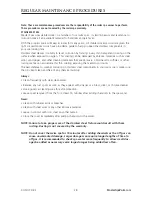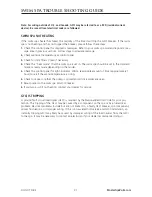
19
DO NOT DIVE.
101
DO NOT DIVE.
8.
Sanitizers:
This is what kills the germs and bacteria that enter the water from the environment
and the human body.
A. Chlorine
1. Only one type is approved for spa use. Sodium dichlor which is granular, fast dissolv-
ing and pH neutral chlorine.
2. Chlorine is an immediate sanitizer and will be added as needed to maintain free chlo-
rine levels between 2.0 to 4.0 ppm..
B. Bromine (Note: Bromine use is not recommended with Eco Pur filters.)
1. Two types of tablets.
a. Hydrotech
b. Lonza
2. Bromine is a slow dissolve chemical and may take a few days to develop a reserve
or reading in the water. Bromine levels should be maintained between 2.0 to 4.0
ppm.
9.
Total dissolved solids (TDS):
Materials that have been dissolved by the water. i.e. Like what
happens when you put sugar in coffee or tea.
10.
Useful life of water (in days):
Water should be drained at least once every 180 days. Useful life
may vary by usage and bather load.
11.
Defoamer:
Foaming may be caused by body oils, cosmetics, lotions, surface cleaners, high
pH or algeacides as well as other organic materials. Low levels of calcium or sanitizer can
also cause foaming. Also, double rinse your bathing suits as they will hold residual soap after
being washed.
12.
Calcium hardness:
Water that is too hard (over 250 ppm) can promote scale formation in
components and on swim spa surface. Water that is too low (below 150 ppm) may also
shorten the life of metal components on the swim spa.
NOTE:
Always leave swim spa cover open for 15 minutes after adding chemicals to prevent
the off gas from damaging your swim spa cover, swim spa pillows, stainless steel hardware
and other critical parts.
WATER CHEMISTRY TERMS YOU SHOULD KNOW
MasterSpaParts.com













































